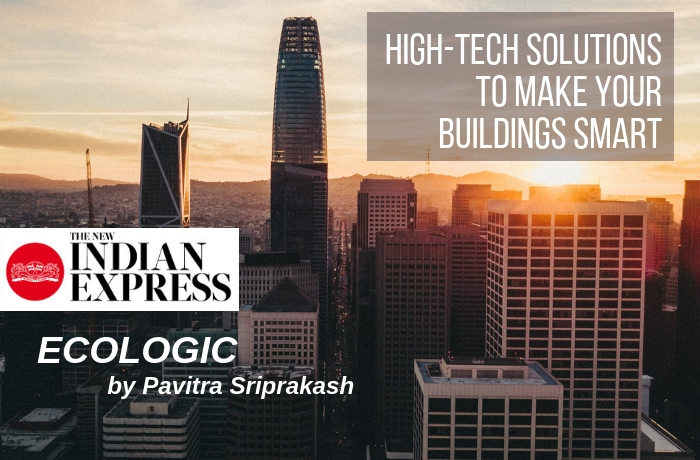19-Oct-2018, Pavitra Sriprakash, Director and Chief Designer, Shilpa Architects Planners Designers Pvt. Ltd, in her weekly column on Sustainability, wrote about “Embodied Energy” during the last week’s article (available here). During a recent panel discussion, she was asked if a Leaf was more high-tech than a smart phone, for which her answer was that the Leaf was “Eco-Tech”. This sparked out a discussion, into a 2-Part article series.. Read below to find out more about embodied energy and making buildings smarter.
Full Article: (Also available on The New Indian Express Page)
Let’s continue to cogitate on the previous question: ‘What is smarter? A smartphone or a leaf’. While it is impossible to ignore the inherent ‘smartness’ of a leaf or gloss over the point that nature has the answers, one cannot also be blind to technological developments that are beneficial, sustainable and smart. ‘High tech’ solutions can be categorised for sustainability depending on the following three factors — 1) Building automation 2) High performance and Efficiency and 3) The crossover from nature to tech.
When it comes to a ‘smart building’, the first thing that pops in our heads is technology. New generation solar panels that track the sun to maximise power output, smart blinds that respond to external conditions to control the microclimate inside homes and offices, and so on. Building Automation Systems (BAS) bring them all together — it is the computerised monitoring and control of fire and safety, HVAC (heating, ventilation and air conditioning), illumination, access, mechanical and electrical systems among others. It is also called a Building Management System (BMS). The core functionality is to keep a building’s design parameters within a comfortable range for the occupants.
A BMS monitors temperature, reduces glare, provides artificial lighting based on occupancy schedules, checks performances, reports device failures of all the equipment, and provides malfunction alarms to the building maintenance staff, and more. They save energy and reduce maintenance costs compared to a ‘non-smart’ building.
While these additional layers to products or engineering interfaces to systems improve performances, increase efficiencies and productivity there are many new products which have built in ‘smart features’ to achieve the same qualities. It is common to hear of high performance glass or insulated roofs. Thermal conductivity of the entire building envelope becomes extremely important as the efficiency of the building’s components and composites determines how much energy is used in heating or cooling the spaces within. Technologies focus on improving occupants’ thermal comfort, and the Thermal Comfort Index defines a building’s smartness or the extent of its ‘high-tech’.
The last aspect is the crossover from nature to technology which seems the most interesting in the whole eco-smart-high-tech space. There are researchers today who are looking to bioengineer sustainable solutions of a different order altogether. Inspired by the lights from fireflies, scientists are working on an idea to turn trees into street lights of the future. Michael Strano, professor of chemical engineering at MIT and the senior author of a study, says: ‘The vision is to make a plant that will function as a desk lamp — a lamp that you don’t have to plug in. The light is ultimately powered by the energy metabolism of the plant itself.’
So, let us internalise the debate on sustainability and think what ‘high tech’ really means to each. With so many options to choose from there seems no right or wrong way. A middle path between back to basics while you reach for the moon seems a harmonious balance between these twofold approaches to sustainability. My firm would strive to include mud and bamboo buildings with bioluminescent trees in the the future. The whole environment can be grown in situ at a project site with very little carbon footprint and negligible end of cycle costs. Hurrah!
If you would like to contribute to the debate, email your thoughts to studio@shilpaarchitects.com!



